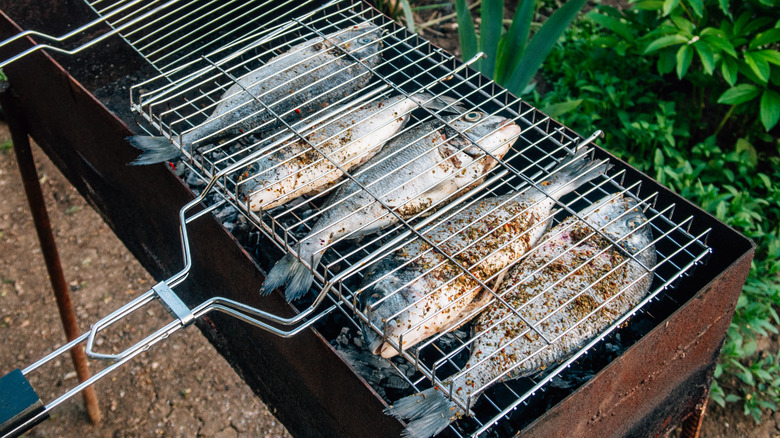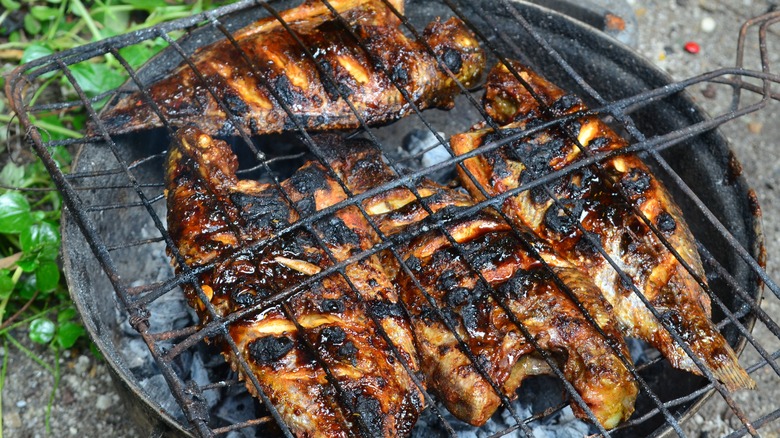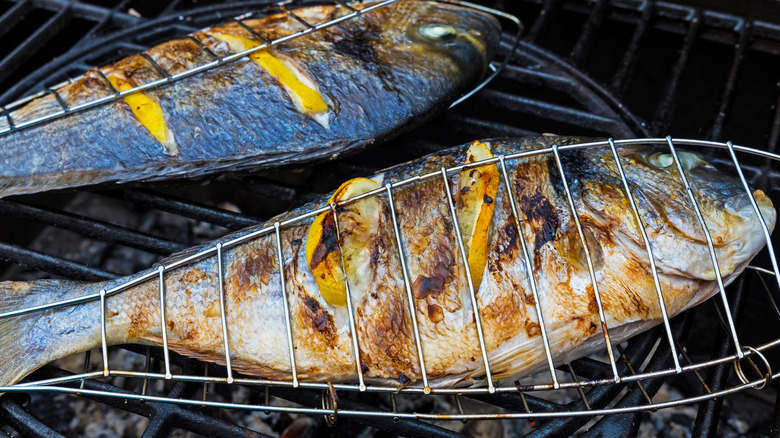What Are Fish Grilling Baskets And When Should You Use One?
If your fish routinely breaks apart, falls through the grates, or generally sticks to the grill like glue when you're cooking on the barbie (and you've avoided all other fish-cooking mistakes), we have three words for you: fish grill baskets. Here's how they work: Imagine a suitcase made of stainless steel metal grates. Just like the suitcase, a fish grill basket has hinges on one side, allowing the case to open and close, as well as a handle on the opposite side for easy carrying. When you're ready to cook your fish, just open up the basket and lay the fish inside. Suitcase comparison aside, this does beat the alternative when the time comes to clean the grill.
Additionally, there are a variety of grill basket designs on the market. Some of them hold a single fish while others are made for multi-fish use, so to speak. Some even deviate from the suitcase design and feature an open top, giving you ready access to the food you're grilling — a nice feature if you want to check doneness without having to open up a basket.
Whichever kind you choose, grill baskets are such a deceptively simple contraption in terms of design that they're easy to dismiss, but in reality, they're oh-so-effective at keeping your grilled fish neat and tidy. Once you use one of these handy-dandy fish flippers, it'll likely become a necessity every time you sizzle up some seafood on the grill.
When to use a fish grilling basket
While you can cook with a grill basket any time you grill fish, there are a few instances in which using one is particularly helpful. The first is with thin fish, which includes types like tilapia, cod, and flounder (by the way, here's what you should know before eating tilapia again). These fish are particularly vulnerable to breaking up because there's just not a lot to them. A grill basket opens up cooking options for you when you're grilling thin fish that would otherwise require different cooking methods. This is true even if you grill the fish over direct heat. Because there's no way that a fish in a basket can get stuck to the grill grates, thin cuts of fish survive the grilling process intact.
The other time when having one of these baskets comes in handy is if you're cooking fish that has a tendency to stick to the grill. Skinless fish can be particularly problematic in this case. Normally, the skin holds the fish's meat together while it's on the grill by creating a barrier between the fish and the grill grate (celeb chef José Andrés even thinks you're missing the best part of grilled fish if you don't use the skin). The fish grill basket works the same way — its metal bars prevent the fish from touching the grill. No grill touching means no grill sticking. Every time you have skinless fish to grill, pull out your basket as a matter of course to prevent sticking.
Types of grill baskets
Fish grill baskets come in a number of shapes and sizes, and usually, they're constructed from either non-stick steel or stainless steel. Carbon steel and cast iron, however, also count among the offerings that you'll find on the market. All in all, the sizes and shapes of the baskets, as well as the materials from which they're made, have both pros and cons.
As far as materials are concerned, non-stick baskets require the least effort come cleanup time, while stainless steel may become discolored after repeated uses. Carbon steel and cast iron fall on opposite ends of the spectrum in terms of weight, with the former being extremely light and the latter being heavier. Carbon steel baskets pick heat up quickly, making for both faster cooking and cool-down time. Cast iron grill baskets, on the other hand, are the Dutch ovens of the grill basket world. That is, they're physically heavy retainers of heat. Carryover cooking can be an issue with these.
Different designs also give grill cooks plenty of options. Some can hold three or four fish and come with compartments. The compartments keep ingredients separated, and depending on the brand, these can be removed to turn the smaller compartments into one big one. Choosing a large basket means you can cook more fish at once — but not just fish. Depending on the design, it's possible to grill veggies and other items in the basket, all while you're cooking the main course. On the other hand, grill baskets that work with a single-fish design mean that cooking for one isn't terribly cumbersome. After all, there's no need to dirty up a big basket to cook just one fish.
Using a fish grill basket is safer than the alternative
Finally, there are a few other reasons to use a grill basket. Chief among them is the safety factor. Many baskets come with long handles that extend out away from the grill. This protects your hands in the same way that the handle of a cooking pot does. It extends out over the burner, reducing the likelihood that you'll have your hands near the heat. If you've had an issue with this sort of thing in the past, you might want to pull out your fish flipper when it's time to fire up the barbie. If you use it, the likelihood of roasting your fingers along with the fish is drastically reduced.
There's another safety benefit to grill baskets, though. Fish baskets prevent pieces of food from falling through the grill grates and into the gas jets or the charcoal. These food chunks cause flare-ups if enough food falls between the grates. At best, this is annoying and makes for more challenging cleanup. At worst, it means singed eyebrows (or other body parts). In other words, your lowly grill basket could be the only thing that stands between you and a trip to the local doc-in-the-box on grill nights.



